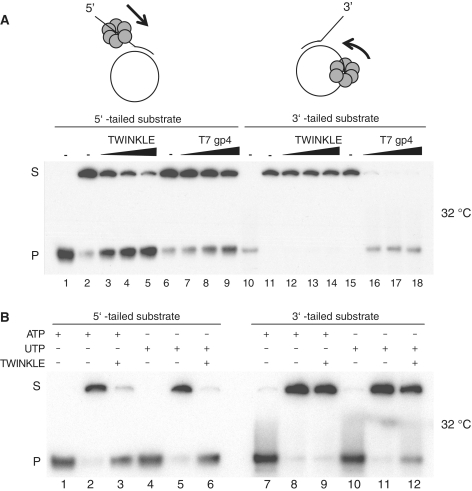Figure 2.
TWINKLE can load onto a circular ssDNA and unwind duplex DNA. (A) Helicase activity of TWINKLE and T7gp4. The DNA substrates used in this study are composed of a 20-bp duplex region and a 40-nt single-stranded overhang (5′ or 3′). The helicase activity is measured as the ability of the protein to separate the annealed 60-nt radiolabeled oligonucleotide from the circular M13ssDNA. The reactions were performed at 32°C as described in ‘Materials and Methods’ section using the 5′-tailed substrate (lanes 1–9) or the 3′-tailed substrate (lanes 10–18) in the presence of 3 mM ATP and increasing amounts of TWINKLE (150, 300 and 600 fmol) or 3 mM dTTP and increasing amounts of T7gp4 (250, 500 and 1000 fmol). Lanes 1 and 10, 5′-tailed and 3′-tailed substrates heated to 100°C before loading; lanes 2 and 6, untreated 5′-tailed DNA substrate; lanes 11 and 15, untreated 3′-tailed DNA substrate; S, double-stranded substrate; P, single-stranded product. (B) Loading of TWINKLE on ssDNA in presence of UTP. Helicase activity of TWINKLE (300 fmol) was measured at 32°C using the 5′-tailed substrate (lanes 1–6) or the 3′-tailed substrate (lanes 7–12) in presence of 3 mM ATP or 3 mM UTP. Lanes 1, 4, 7 and 10, DNA substrates heated to 100°C before loading.

